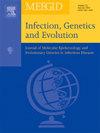黑龙江省丙型肝炎病毒基因型流行及耐药分析
IF 2.6
4区 医学
Q3 INFECTIOUS DISEASES
引用次数: 0
摘要
丙型肝炎仍对公共安全构成威胁,而黑龙江省有关丙型肝炎病毒(HCV)的报道很少。因此,我们旨在研究黑龙江省丙型肝炎病毒(HCV)的流行病学和耐药性相关变异(RAS),并探讨治疗效果。我们对来自黑龙江省的 7019 份标本进行了基因型鉴定。利用自回归整合移动平均(ARIMA)模型预测2024年至2030年HCV感染趋势。对基因型(GT)1b和2a样本进行了Sanger测序,以调查RAS。我们进行了系统发育分析,以评估本地与其他国家的 HCV 序列的相似性。此外,我们还追踪了接受 DAAs 治疗的患者的疗效以及疗效与 RAS 之间的关系。黑龙江的主要HCV亚型为1b(47.51%)和2a(43.85%)。从 2012 年到 2023 年,GT2a、GT3a、GT3b 和 GT6a 的比例逐渐上升。未来七年,GT2a 的发病率将超过 GT1b。GT1b 和 GT2a NS5A 区域的 RAS 所占比例分别为 70.47 % 和 15.22 %。而 GT1b NS5B 区的 RAS 所占比例为 100%。本地的 HCV 序列与其他国家的序列存在系统发育关系。GT1b R30Q 和 GT2a C92S 与药物疗效相关。文献中未报道的 K107R 和 P206S 也与药物疗效有关。在黑龙江,HCV 基因型的流行情况越来越多样化。HCV GT1b种类繁多,RAS比例较高,感染该基因型HCV的患者在治疗前需要进行测序。本文章由计算机程序翻译,如有差异,请以英文原文为准。
Prevalence and drug resistance analysis of hepatitis C virus genotypes in Heilongjiang, China
Hepatitis C still poses a threat to public safety, and there are few reports of hepatitis C virus (HCV) in Heilongjiang Province. Therefore, we aimed to study the epidemiology and resistance-associated substitutions (RASs) of HCV in Heilongjiang and explore the efficacy of treatment. 7019 specimens from Heilongjiang Province were subjected to the genotype identification. The Autoregressive Integrated Moving Average (ARIMA) model was utilized to predict HCV infection trends from 2024 to 2030. The Sanger sequencing was performed on samples of genotype(GT) 1b and 2a to investigate RASs. Phylogenetic analysis was conducted to assess the similarity of local HCV sequences with those from other countries. In addition, we tracked the effect of patients treated with DAAs and the relationship between efficacy and RASs. The predominant HCV subtypes in Heilongjiang were 1b (47.51 %) and 2a (43.85 %). From 2012 to 2023, the proportions of GT2a, GT3a, GT3b, and GT6a gradually increased. And the prevalence of GT2a will exceed that of GT1b over the next seven years. The proportion of RASs in GT1b and GT2a NS5A region was 73.47 % and 15.22 %, respectively. And the proportion of RASs in GT1b NS5B region was 100 %. Local HCV sequences exhibited phylogenetic relationships with sequences from other countries. The GT1b R30Q and GT2a C92S were correlated with drug efficacy. K107R and P206S, which have not been reported in the literature, were also related to drug efficacy. The epidemiology of HCV genotypes in Heilongjiang is becoming increasingly diverse. HCV GT1b has a large variety and a high proportion of RASs, and patients infected with this genotype of HCV need to be sequenced before treatment.
求助全文
通过发布文献求助,成功后即可免费获取论文全文。
去求助
来源期刊

Infection Genetics and Evolution
医学-传染病学
CiteScore
8.40
自引率
0.00%
发文量
215
审稿时长
82 days
期刊介绍:
(aka Journal of Molecular Epidemiology and Evolutionary Genetics of Infectious Diseases -- MEEGID)
Infectious diseases constitute one of the main challenges to medical science in the coming century. The impressive development of molecular megatechnologies and of bioinformatics have greatly increased our knowledge of the evolution, transmission and pathogenicity of infectious diseases. Research has shown that host susceptibility to many infectious diseases has a genetic basis. Furthermore, much is now known on the molecular epidemiology, evolution and virulence of pathogenic agents, as well as their resistance to drugs, vaccines, and antibiotics. Equally, research on the genetics of disease vectors has greatly improved our understanding of their systematics, has increased our capacity to identify target populations for control or intervention, and has provided detailed information on the mechanisms of insecticide resistance.
However, the genetics and evolutionary biology of hosts, pathogens and vectors have tended to develop as three separate fields of research. This artificial compartmentalisation is of concern due to our growing appreciation of the strong co-evolutionary interactions among hosts, pathogens and vectors.
Infection, Genetics and Evolution and its companion congress [MEEGID](http://www.meegidconference.com/) (for Molecular Epidemiology and Evolutionary Genetics of Infectious Diseases) are the main forum acting for the cross-fertilization between evolutionary science and biomedical research on infectious diseases.
Infection, Genetics and Evolution is the only journal that welcomes articles dealing with the genetics and evolutionary biology of hosts, pathogens and vectors, and coevolution processes among them in relation to infection and disease manifestation. All infectious models enter the scope of the journal, including pathogens of humans, animals and plants, either parasites, fungi, bacteria, viruses or prions. The journal welcomes articles dealing with genetics, population genetics, genomics, postgenomics, gene expression, evolutionary biology, population dynamics, mathematical modeling and bioinformatics. We also provide many author benefits, such as free PDFs, a liberal copyright policy, special discounts on Elsevier publications and much more. Please click here for more information on our author services .
 求助内容:
求助内容: 应助结果提醒方式:
应助结果提醒方式:


